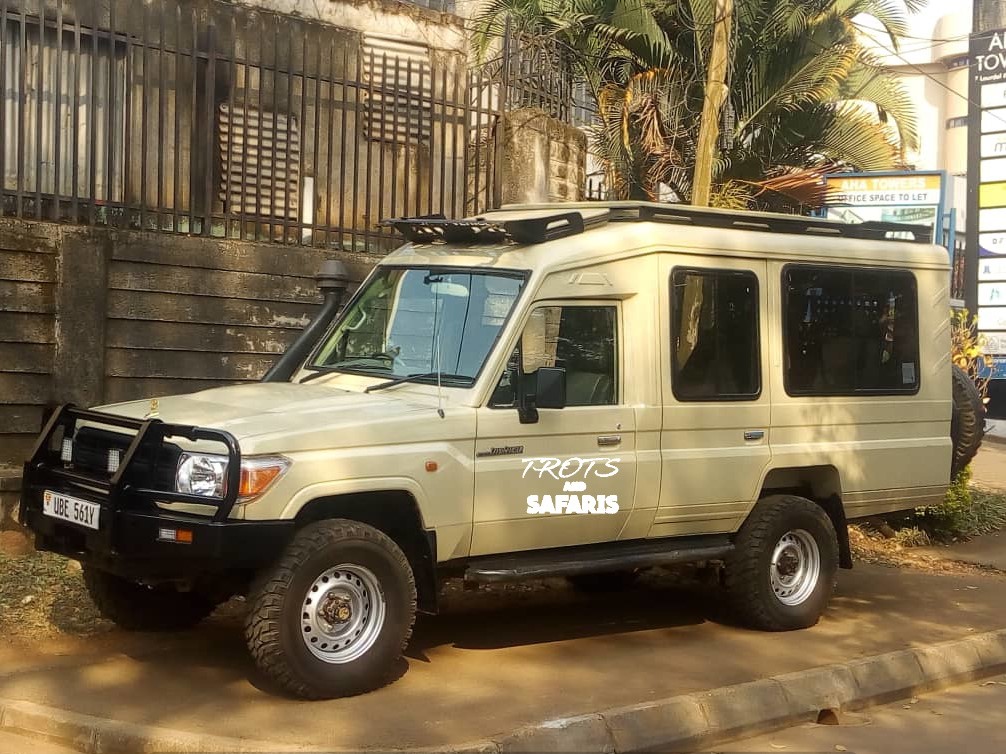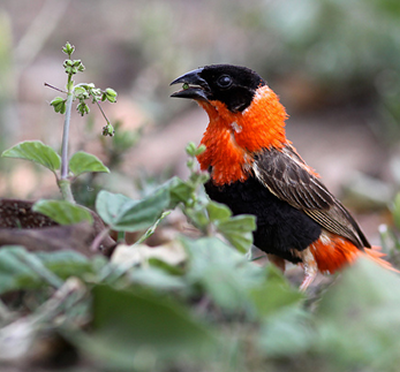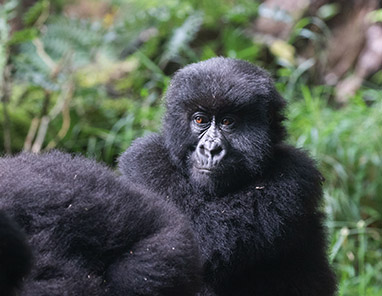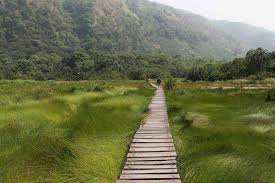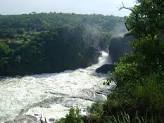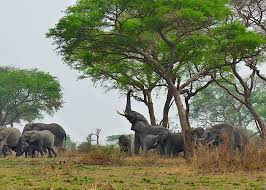Primates walk (Chimpanzee tracking)
The most favourite of Kibale’s walks embarks on from the Kanyanchu Visitor center at 08.00 & 15.00 and lasts 2 to 3 hours. Chimpanzee are the most sought after primate by visitors, but you should look out for the black & white colobus, red tailed monkey or the grey cheeked mangabey. Your guides will be able to show you pittas & different bird species and will give details of the tradit of the plant species within the forest. This walk is for 6 people in a group. Advance booking is all-important especially during peak sea.
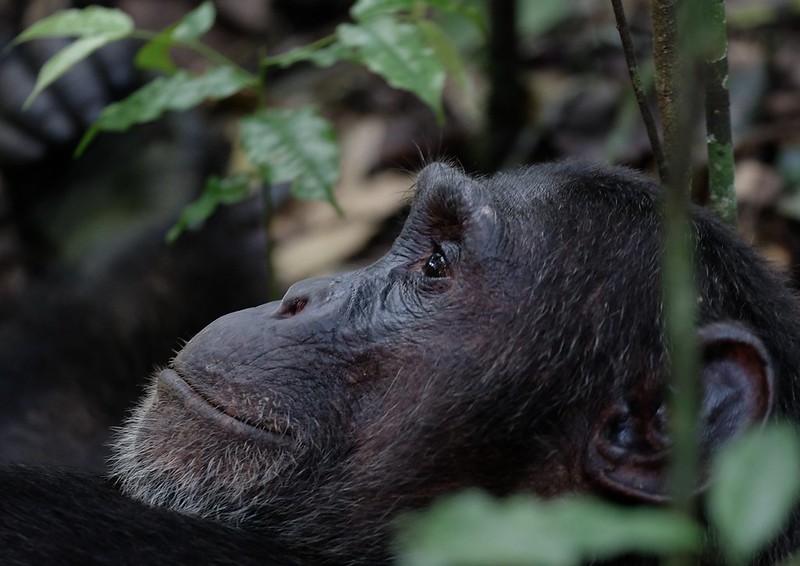
Chimpanzee tracking has rules and regulations to follow
A distance of just about 8m is very important between you and the chimps.
People with diseases such as flue or diarrhea may not allowed in the park.
Avoid eating near the chimps.
Children below the age of 12 are prohibited from entering the park.
Guide is the only one to help get access to the forest.
Chimps need freedom therefore no provoking them once you enter the park.
Flash photography are not allowed in the park.
The most favorite activity in the park is the Chimpanzee tracking in Uganda. Starts from Kanyanchu Visitor Center at 08.00 & ends at 15.00 and lasts 2-3 hours. The Primates are searched down by visitors during the tracking. These include black & white Colobus, grey cheeked Mangabey, red tailed monkey. Your guides will show you pittas along with other bird species & will explain the tradition of different plant species within the forest. This walk is for 6 individuals per tour group. Advance booking is all-important during peak sea:
Chimpanzee tracking
Chimpanzee tracking actually is a very fascinating experience. Prepare today and set out to Uganda’s Kibale all natural jungle today as you spend a number of hours tracking these impressive creatures. You will be allowed to spend some time (at most an hour) with our mesmerizing relatives, as you observe them swing from one tree to another, feed, play about or progress speedily on the ground right in front of you.
Chimpanzees as well as humans share over 98 percent of their DNA.
However these being wild animals, chances of spotting these chimps are not always guaranteed although they are over 95% within the Kibale Forest, hence making it the most perfect destination in the whole of East Africa for chimpanzee tracking.
It is in addition probable to take part in the fascinating habituation experience, meaning that you can actuallty get a chance to spend the entire day with this impressive creatures.
However, because the number of chimpanzee trekking permits for each day is restricted, you are greatly advised to book in advance to your safari date.
Normally lunch boxes may be offered to the trekkers that are taking part in the habituation process since it requires the entire day.
Important to Note is that 15 years is the minimum age allowed to take part in the chimpanzee tracking experience
What to carry along
Wear shoes that have a good grip, suitable for climbing steep moist muddy slopes
A number of people actually feel more at ease when wearing clothes that are long sleeved as this will protect them from the pricking thickets as they move through the verdant jungle
Do not forget a rain gear, since the weather here is highly unpredictable
Bring enough drinking water plus snacks to bite on
Carry a pair of binoculars
If taking photos, keep in mind that your subjects are actually black animals living within dim light, so camera flashes is strictly not permitted. Better to have a fast film (of 400 – 800 ASA) or even utilize the settings on your camera.
About Chimpanzees
The average weight of an adult well grown male chimpanzee is between 35 and 70 kilograms, with a height of approximately 3 meters whereas tan adult female chimpanzee weighs between 26 and 50 kilograms and a height between 2 and 4 feet.
A chimpanzee’s life expectancy is at 40 years whereas that for those living in captivity can extend up to 60 years.
In Uganda today, Efforts to actually conserve the chimpanzees are extensively acknowledged and well supported. Actually The Jane Goodall Foundation has played a major role in the overall conservation of not only these Chimpanzees but the Gorillas as well found in Uganda. By going for chimpanzee tracking, you directly contribute to the conservation efforts.
Chimpanzees are the closest relatives to humans sharing about 98% of their DNA composition with humans. They are Sociable, intelligent as well as communicative and among their very fascinating traits is the ability to utilize tools like rocks for crushing nuts, empty pods for hollowing out water plus sticks for capturing termites from their holes. These skills are for long been passed on from generation to another and researchers say that different troops have specialist tasks, basing on their habitat as well as diet.
Chimps stay in groups of 10 – 100 members. They can babysit each other’s young, kiss, groom one another and even hold hands. The young chimps become independent at the age of 4 year. Nonetheless, chimps can be aggressive and unsociable, mainly if disturbed.
Although they spend some time on ground, they normally feed and do make their sleeping nests up in the trees. Their diet varies comprising of leaves, seeds, fruit plus flowers.
About Chimpanzee Habituation Experience
Chimpanzee Habituation Experience,this is a lifetime experience that allows accompany Kibale’s researchers and habituation at chimpanzee during their daily activities, thereby getting used to human presence without changing their natural. During your tour, expect coming across the chimps de-nesting (in their nocturnal nests) between 05.30 to 06.30, before them throughout the day till they make new nests and the night around 19.00. The Habituation Experience by tourist for low season months of March, April, May and November
For more details about your chimps trekking safari, contact Trots and Safaris at;
Web: www.trotsandsafari.com
Email: info@trotsandsafari.com
Lets join this fascinating experience with our close relatives in the wild.
Gorilla trekking is one of the famous safari activities in Uganda. It has been observed that the population of mountain gorillas has increased thanks to the conservation efforts of various non governmental and government support. These areas are safe for tourists and gorillas alike with minimal or no poaching incidences reported because of alternative sources of incomes available to communities in the area due to increase revenues from gorilla tourism.
The mountain gorillas are often found in the undergrowth feeding on the vegetation as they rest and or groom each other. The leader of each gorilla family or group is a silver-back which is very protective of the family, if frustrated it will grunt and beat its chest before moving off with the females, offspring and mature males.
To enjoy the experience of gorilla trekking, you need to prepare adequately starting with choice of tour operator to plan the entire safari, lodges and purchase of gorilla permits. The minimum age for trekking gorillas is 15 years. You require to purchase your permit much earlier especially if you want a specific date because only 8 people can trek a gorilla family per day.
Gorilla trekking happens in Bwindi impenetrable national Park and Mgahinga gorilla national park. Uganda currently has 21 gorilla families available for trekking. The trekking in Bwindi is slightly different from Mgahinga because of the nature of the landscape. Bwindi is a rain forest with thick undergrowth and varying landscape, you will have experiences of both uphill and downhill on your hike. Bwindi is divided into different sectors each with a number of gorilla families. Before you book your lodge it is important to know which sector you will track because the location is quite far a part. The sectors are Buhoma, Ruhija, Nkuringo and Rushaga sectors.
In Mgahinga the gorillas are mainly found in the mid vegetation on the Virunga volcanoes in Mgahinga gorilla national park especially in the open areas of the bamboo zone.
Gorilla trekking safari preparation tips
- Uganda is a tropical country with unpredictable climate, rain gear is a must have
- Insect repellent
- Recommended clothing – long trousers and long sleeved sweaters or shirts while in the forest to avoid insect and plant stings.
- Sturdy hiking boots are essential, especially ones you have used before.
- Drinking water, however eating, drinking and smoking near the gorillas is strictly forbidden – your guide will communicate designated time and place.
- Photography is permitted, although you must not use flash
- Porters are available to help you carry your day-pack for a small charge.
- You will not be allowed to trek gorillas if you have communicable disease like flu or cough
Mountain gorillas live at high altitude and this may cause difficulties in hiking up for some visitors. You should pace yourself, walk slowly, drink plenty of water and prepare adequately for this experience. Kagera safaris will purchase your gorilla trekking permits for you in advance for proper planning.
Uganda Gorilla Trekking Tours
Uganda wants to welcome tourists again. Ahead of the scheduled reopening of borders including the Entebbe International Airport on 1st October 2020, Uganda’s’ President Yoweri Museveni in his just televised address this evening of 20th September, announced the lifting of entry to tourists as follows:Restrictions on tourists shall be lifted provided they test negative for COVID-19 72 hour’s prior to arrival.That they travel directly to their destinations or designated hotels without mixing with the community.Hotels shall be allowed to operate as agreed in observance of the Standard Operational Procedures (SOP’s).Restaurants shall continue to operate with limited patrons preferably on a takeaway/to-go or delivery basis.
The President however declined to reopen bars because the sobriety of patrons cannot be guaranteed and therefore allow them to observe social distancing.The bi-annual traditional circumcision custom practiced by the Bamasaba tribe that hails from the slopes of Mt.Elgon has been allowed. They shall carry out their rites provided that they follow the agreed SOP’s as agreed with the Ministry of Health. Their animated ’embalu ‘dance procession also known as ‘kadodi ‘shall not be allowed to continue because in the words of the President,’ that is dangerous congregating’.Cumulative covid19 cases stand at 6287 with 63 deaths since the lockdown was first announced following the closure of all borders on 21st March 2020.
For your booking enquiry, click on our website below;
Web: www.trotsandsafari.com
Email: info@trotsandsafari.com
PARK AT A GLANCE
Size: 220km² with an altitude of 670-760m above sea level
Semliki Forest Reserve was created in 1932 and upgraded to national park status in 1993.
It is the only tract of true lowland tropical forest in East Africa, hosting 441 recorded bird species and 53 mammals.
Large areas of this low-lying park may flood during the wet season,a brief reminder of the time when the entire valley lay at the bottom of a lake for seven million years.
Four distinct ethnic groups live near the park – Bwamba farmers live along the base of the Rwenzori while the Bakonjo cultivate the mountain slopes. Batuku cattle keepers inhabit on the open plains and Batwa pygmies, traditionally hunter gathers, live on the edge of the forest.
Semliki National Park sprawls across the floor of the Semliki Valley on the remote, western side of the Rwenzori. The park is dominated by the easternmost extension of the great Ituri Forest of the Congo Basin. This is one of Africa’s most ancient and bio-diverse forests; one of the few to survive the last ice age, 12-18,000 years ago.
The Semliki Valley contains numerous features associated with central rather than eastern Africa. Thatched huts are shaded by West African oil palms; the Semliki River (which forms the international boundary) is a miniature version of the Congo River, the forest is home to numerous Central African wildlife species, and the local population includes a Batwa pygmy community that originated from the Ituri. As a result, this park provides a taste of Central Africa without having to leave Uganda.
While Semliki’s species have been accumulating for over 25,000 years, the park contains evidence of even older processes. Hot springs bubble up from the depths to demonstrate the powerful subterranean forces that have been shaping the rift valley during the last 14 million years.
size: 795km2
Kibale is highest at the park’s northern tip, which stands 1,590m above sea level. The lowest point is 1,100m on the floor of the Albertine Rift Valley to the south.
over 351 tree species have been recorded in the park, some rise to over 55m and are over 200 years old.
Kibale’s varied altitude supports different types of habitat, ranging from wet tropical forest on the Fort Portal plateau to woodland and savanna on the rift valley floor.
Kibale is one of Africa’s foremost research sites. While many researchers focus on the chimpanzees and other primates found in the park, others are investigating Kibale’s ecosystems, wild pigs and fish species, among other topics.
Kibale National Park contains one of the loveliest and most varied tracts of tropical forest in Uganda. Forest cover, interspersed with patches of grassland and swamp, dominates the northern and central parts of the park on an elevated plateau.Kibale is famously known for Chimpanzee tracking
The park is home to a total of 70 mammal species, most famously 13 species of primate including the chimpanzee.
It also contains over 375 species of birds. Kibale adjoins Queen Elizabeth National Park to the south to create a 180km-long corridor for wildlife between Ishasha, the remote southern sector of Queen Elizabeth National Park, and Sebitoli in the north of Kibale National Park.The Kibale-Fort Portal area is one of Uganda’s most rewarding destinations to explore. The park lies close to the tranquil Ndali-Kasenda crater area and within half a day’s drive of the Queen Elizabeth, Rwenzori Mountains and Semuliki National Parks, as well as the Toro-Semliki Wildlife Reserve
PARK AT A GLANCE
Size: 33.7km2, making it Uganda’s smallest National Park.
The park takes its name from “Gahinga” – the local word for the piles of volcanic stones cleared from farmland at the foot of the volcanoes.
The British administration declared the area a game sanctuary in 1930; it was gazetted as a National Park in 1991.
Mgahinga has one habituated trans-boundary gorilla group.
The Batwa were self-sufficient – and visitors can see how during a fascinating tour with a Batwa guide to learn the secrets of the forest.
Mgahinga Gorilla National Park sits high in the clouds, at an altitude of between 2,227m and 4,127m. As its name suggests, it was created to protect the rare mountain gorillas that inhabit its dense forests, and it is also an important habitat for the endangered golden monkey.
As well as being important for wildlife, the park also has a huge cultural significance, in particular for the indigenous Batwa pygmies. This tribe of hunter-gatherers was the forest’s “first people”, and their ancient knowledge of its secrets remains unrivalled.
Mgahinga’s most striking features are its three conical, extinct volcanoes, part of the spectacular Virunga Range that lies along the border region of Uganda, Congo and Rwanda. Mgahinga forms part of the much larger Virunga Conservation Area which includes adjacent parks in these countries. The volcanoes’ slopes contain various ecosystems and are biologically diverse, and their peaks provide a striking backdrop to this gorgeous scenery.
Size: 220km² with an altitude of 670-760m above sea level
Semuliki Forest Reserve was created in 1932 and upgraded to national park status in 1993. It is the only tract of true lowland tropical forest in East Africa, hosting 441 recorded bird species and 53 mammals.
Large areas of this low-lying park may flood during the wet season,a brief reminder of the time when the entire valley lay at the bottom of a lake for seven million years.
Four distinct ethnic groups live near the park – Bwamba farmers live along the base of the Rwenzori while the Bakonjo cultivate the mountain slopes. Batuku cattle keepers inhabit on the open plains and Batwa pygmies, traditionally hunter gathers, live on the edge of the forest.
Semuliki National Park sprawls across the floor of the Semliki Valley on the remote, western side of the Rwenzori. The park is dominated by the easternmost extension of the great Ituri Forest of the Congo Basin. This is one of Africa’s most ancient and bio-diverse forests; one of the few to survive the last ice age, 12-18,000 years ago.
The Semliki Valley contains numerous features associated with central rather than eastern Africa. Thatched huts are shaded by West African oil palms; the Semliki River (which forms the international boundary) is a miniature version of the Congo River, the forest is home to numerous Central African wildlife species, and the local population includes a Batwa pygmy community that originated from the Ituri. As a result, this park provides a taste of Central Africa without having to leave Uganda.
While Semuliki’s species have been accumulating for over 25,000 years, the park contains evidence of even older processes. Hot springs bubble up from the depths to demonstrate the powerful subterranean forces that have been shaping the rift valley during the last 14 million years.
do not miss the natives of the park, the birds, tree species and the hot springs.
web: www.trotsandsfari.com
email:info@trotsandsafari.com
PARK AT A GLANCE
Size: 370km2
Altitude: 1,220m – 1,828m above sea level.
Lake Mburo National Park is a compact gem, located conveniently close to the highway that connects Kampala to the parks of western Uganda. It is the smallest of Uganda’s savannah national parks and underlain by ancient Precambrian metamorphic rocks which date back more than 500 million years. It is home to 350 bird species as well as zebra, impala, eland, buffalo, oribi, Defassa waterbuck, leopard, hippo, hyena, topi and reedbuck.
Together with 13 other lakes in the area, Lake Mburo forms part of a 50km-long wetland system linked by a swamp. Five of these lakes lie within the park’s borders. Once covered by open savanna, Lake Mburo National Park now contains much woodland as there are no elephants to tame the vegetation. In the western part of the park, the savanna is interspersed with rocky ridges and forested gorges while patches of papyrus swamp and narrow bands of lush riparian woodland line many lakes. Let us take you on this journey of adventure.
web: www.trotsandsafari.com
Email:info@trotsandsafari.com
PARK AT A GLANCE
Size: 3,840km2
Murchison Falls became one of Uganda’s first national parks in 1952
At Murchison Falls, the Nile squeezes through an 8m wide gorge and plunges with a thunderous roar into the “Devil’s Cauldron”, creating a trademark rainbow
The northern section of the park contains savanna and borassus palms, acacia trees and riverine woodland. The south is dominated by woodland and forest patches
The 1951 film “The African Queen” starring Humphrey Bogart was filmed on Lake Albert and the Nile in Murchison Falls National Park
Murchison Falls National Park lies at the northern end of the Albertine Rift Valley, where the sweeping Bunyoro escarpment tumbles into vast, palm-dotted savanna. First gazetted as a game reserve in 1926, it is Uganda’s largest and oldest conservation area, hosting 76 species of mammals and 451 birds.
The park is bisected by the Victoria Nile, which plunges 45m over the remnant rift valley wall, creating the dramatic Murchison Falls, the centerpiece of the park and the final event in an 80km stretch of rapids. The mighty cascade drains the last of the river’s energy, transforming it into a broad, placid stream that flows quietly across the rift valley floor into Lake Albert. This stretch of river provides one of Uganda’s most remarkable wildlife spectacles. Regular visitors to the riverbanks include elephants, giraffes and buffaloes; while hippos, Nile crocodiles and aquatic birds are permanent residents.
Notable visitors to the park include Winston Churchill, Theodore Roosevelt, Ernest Hemingway and several British royals.
discover the beauty of Murchison falls national park with trots and safaris
web: www.trotsandsafari.com
email: info@trotsandsafari.com
PARK AT A GLANCE
Size: 1,978km².
Queen Elizabeth spans the equator line; monuments on either side of the road mark the exact spot where it crosses latitude 00. The park was founded in 1952 as Kazinga National Park, and renamed two years later to commemorate a visit by Queen Elizabeth II. The park is home to over 95 mammal species and over 600 bird species.
The Katwe explosion craters mark the park’s highest point at 1,350m above sea level, while the lowest point is at 910m, at Lake Edward.
Queen Elizabeth National Park is understandably Uganda’s most popular tourist destination. The park’s diverse ecosystems, which include sprawling savanna, shady, humid forests, sparkling lakes and fertile wetlands, make it the ideal habitat for classic big game, ten primate species including chimpanzees and over 600 species of birds.
Set against the backdrop of the jagged Rwenzori Mountains, the park’s magnificent vistas include dozens of enormous craters carved dramatically into rolling green hills, panoramic views of the Kazinga Channel with its banks lined with hippos, buffalo and elephants, and the endless Ishasha plains, whose fig trees hide lions ready to pounce on herds of unsuspecting Uganda kob.
As well as its outstanding wildlife attractions, Queen Elizabeth National Park has a fascinating cultural history. There are many opportunities for visitors to meet the local communities and enjoy storytelling, dance, music and more. The gazetting of the park has ensured the conservation of its ecosystems, which in turn benefits the surrounding communities.
Discover queen elizabeth wonders with trotsandsafaris.
Web: www.trotsandsafari.com
Email: info@trotsandsafari.com
- 1
- 2

